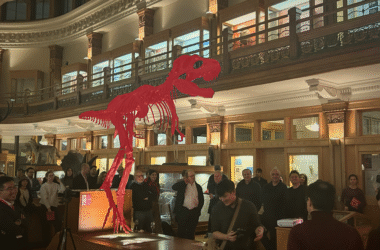 chemgapedia.de
chemgapedia.deDr. Nada Jabado, an associate professor of pediatrics at McGill, recently led an international cohort of scientists in search of the genetic factors behind the onset of childhood brain cancer. The study, published in Nature, uncovered two important mutations that affect the regulation of the genome.
Glioblastoma multiforme, a type of brain tumor, is the leading cause of cancer-related mortality in children. It is a feared diagnosis, as the vast majority of patients succumb to the disease within a few years despite intensive medical intervention.
“For these children, Glioblastoma is a death sentence,” Jabado said.
Jabado’s research strove to reveal the disease’s molecular agency and address the cancer’s unresponsiveness to conventional therapies such as chemotherapy and radiation.
Interestingly, the research identified mutation H3.3, a histone structure variant, as the molecular driver behind this form of brain cancer. This mutation was initially striking to researchers due to the universal nature of the histone, which is conserved not only amongst humans but also across a wide range of species.
Histones are a category of DNA-binding proteins that facilitate DNA compaction so that mass quantities of genetic information can fit into each microscopic cell. Histones play a universal and essential role in gene regulation—the addition of a molecular tag to the histone tail can determine if a gene will be expressed or not.
The discovery of a cancer-causing mutation to a histone protein differs from the common consensus of what initiates the development of cancer. In the past, scientists believed that the source of the disease was a mutation to the underlying gene, not its epigenetic regulator.
Jabado’s research is also significant in that it illustrates how the characteristics of a cancer can vary between children and adults, even when the resulting tumours are indistinguishable.
“What we found was that there was a different molecular signature in children,” Jabado said. “In adult cancers, there are usually multiple drivers but in children there might be a single one.”
This research sheds light on the need for a more individualized approach to medicine; tumours in adults and children do not arise in the same way, and they should therefore not be treated in the same way.
Despite this genetic breakthrough, there is currently no viable treatment option that can specifically target these histone mutations. Jabado hopes to take on that problem next, by lobbying for targeted therapies.
Even though there is no immediate solution for the inherent genetic contribution to childhood brain cancer, the results of this study bring hope for the future. By deciphering the genome, the search for a cure is “not a blind process,” as Jabado explained.
“Genetics can identify the cause, which you can then act on,” she said.
Jabado predicts that the future of cancer therapy will be much more individualized, where each patient will receive a specific treatment program designed around two targetable mutant drivers. If this becomes reality, researchers believe that we will not only see better therapeutic results, but also a reduction in the number of wasted resources. Simply put, the information provided by our genome can transform the treatment of cancer into a much more efficient process.
In an era of skyrocketing medical costs, this could prove to be immensely beneficial to our health care system.
When asked how future scientists should approach big problems, Jabado urges McGill students “to stay curious, [for] what is true today, might not be true tomorrow.”





